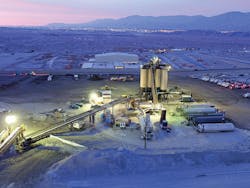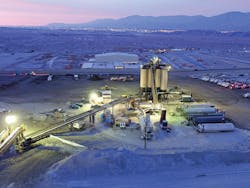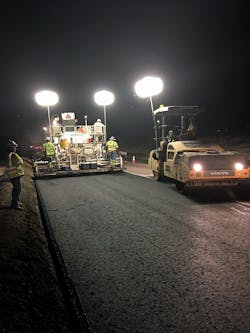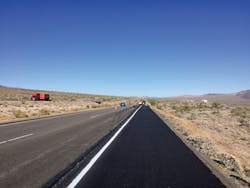Out in the desert
When working on one of the largest pavement rehabilitation projects in the history of the California Department of Transportation (Caltrans) on one of the busiest interstate highways in the U.S., any contractor is going to have their work cut out for them.
Such was the task that Granite Construction was commissioned by Caltrans to complete along a 31.4-mile stretch of I-10 in Riverside County near the underpopulated Desert Center region back in May 2016.
“This stretch is in the middle of the desert—about 30 miles from the nearest city with any substantial population,” Scott Howard, project manager for Granite Construction, told Roads & Bridges. The aforementioned significantly populated nearby city is Indio, dubbed “The City of Festivals” of the Greater Palms Springs area as it is home to the Coachella Valley Music and Arts Festival, among other major events. These festivals, combined with the warmer climate of southern California, make this corridor a prominent connector for tourist hot spots.
“We’re close to the city of Palm Springs,” Muin Mustafa, project manager for Granite Construction, told Roads & Bridges. “A lot of people like to come here during the winter months because the weather is gorgeous out here in the winter. So you see a lot of people from colder climates come down and spend the winter here.”
The I-10 pavement rehabilitation project was a collaborative effort between Granite Construction and Caltrans District 8. The rehabbed section of I-10 covered approximately 63 lane-miles traveling both eastbound and westbound along the two-lane highway. In the end, the contractor laid down a grand total of 698,348 tons of asphalt along the corridor. The massive amounts of asphalt pavement required on the project combined with the close collaboration with Caltrans are some of the highlights that earned Granite Construction a 2018 Quality in Construction (QIC) Award for excellence in construction of an asphalt pavement from the National Asphalt Pavement Association (NAPA).
At the asphalt plant, Granite had to regularly manage extensive quality control and testing requirements. Tests were conducted at a frequency of every 4,000 and 10,000 tons.
Night work on a busy route
After the team worked to widen some of the existing slopes, paving work began in early July 2016 on the I-10 rehab. The corridor is a major thoroughfare for trucks and goods moving between Los Angeles and Phoenix, and approximately 13,000 vehicles traverse the roadway daily, 36% of which is truck traffic. As such, a majority of the paving work was carried out during nighttime hours in order to significantly decrease the traffic impacts to the traveling public.
“We were restricted to night hours working on this project, and were restricted to certain days that we couldn’t be on the roadway due to the amount of traffic,” Mustafa said. The team at Granite worked to create highly effective planning efforts to overcome challenges with traffic management and weather impacts to operations. “Weather, for the most part, is fairly consistent out here in the desert. [When] you have your rain days and you have your colder temperatures, we can’t pave. But that didn’t really delay the project at all.”
In addition to working around heavier traffic volumes on I-10, Granite worked hard to maintain a culture of safety on the project, accounting for only one OSHA-recordable injury over the 1.5 years of construction. “Being on a freeway at night with the traveling public, we had to make sure our closures were correctly installed,” Howard said. “So that was something that we touched on quite a bit, to make sure that everyone that came to work went home in the same condition.”
“We had work plans for everything that we did out there that included a job hazard analysis for each task,” Mustafa added. “So everything that could’ve posed a safety issue was assessed and addressed. So we do ‘take fives’ at the start shift. And then at the end of shift we would debrief with the project team.”
A majority of paving work on I-10 was carried out during nighttime hours in order to decrease traffic impacts to the traveling public.
Paving the way
One reason for the I-10 pavement rehabilitation project receiving the NAPA QIC award was for its implementation of green/sustainable practices and materials in asphalt paving. This included using an asphalt mix composed of 15% reclaimed asphalt pavement (RAP), as called for by Caltrans specs, plus 20% recycled tire rubber.
The large-scale project involved 1.6 million sq yd of asphalt cold planing. The lift specs for the new pavement included 521,000 tons of 25-mm Superpave dense-graded hot-mix asphalt for the base at a 0.2 ft to 0.8 ft thickness, plus 177,000 tons of 19-mm Superpave rubber gap-graded rubberized hot-mix asphalt at 0.2 ft thickness. The paving team averaged around 3,500 tons per day on the base mix, while the rubberized surface mix averaged closer to 2,500 tons per day. “The rubber mix was a little more finicky so we didn’t push the envelope on the rubber,” Mustafa said. “We kind of slowed down our production there.”
At the asphalt plant, Granite had to regularly manage extensive quality control and testing requirements. “Caltrans has pretty elaborate contractor quality control requirements that are required daily,” Vishal Jakkaraju, quality control manager for Granite Construction, told Roads & Bridges. “And at certain frequencies, testing. The daily plant quality control would involve basic items like asphalt content gradation that would be done on a daily basis.”
According to Jakkaraju, tests were conducted at a frequency of every 4,000 and 10,000 tons. Testing was required for air voids and voids in the mineral aggregate (VMA), as well as tensile strength ratio (TSR) requirements and Hamburg rut testing requirements, all of which took place at various frequencies. “Almost every 10,000 tons we would have to pull a sample and test,” Jakkaraju said. “And at every sampling milestone, there would be samples provided to the quality assurance group for them to test. So there would be side-by-side comparisons of quality control and quality assurance test results to make sure everything’s going smoothly and there’s no red flags. There would be occasions where there would be some discrepancy between the two test data. But due to our good relationships and partnering sessions, we were able to sort out the differences, identify the root causes and make corrective actions as needed so that there wouldn’t be too much impact on the project schedule and the integrity of the project.”
The western end of the project on I-10 was the closest side to the asphalt plant, roughly 35 to 40 minutes away for trucks to circle around with new batches. On that side of the corridor, about five to six loads of asphalt were delivered each night. On the farther end, trucks took closer to an hour to reach the paving crews with new asphalt, bringing in around three or four loads per night. As paving work made its way further from the plant, the contractor would add to the number of trucks making deliveries.
For the paving train, Granite Construction ran a Roadtec SB-2500C Shuttle Buggy and BOMAG MS2 for material transfer followed by Terex CR562 and Cat AP-655C pavers. A Volvo DD110B roller served as the breakdown roller, while a Cat PS360C served as an intermediate roller. This was followed by a finish Volvo DD90 roller. The team also utilized two Wirtgen milling machines.
For compaction, the required density by Caltrans ranged from 91-97%. Granite Construction consistently landed between 93-94% for density.
Approximately 13,000 vehicles traverse I-10 on a daily basis, 36% of which is truck traffic. The route serves as a major trucking corridor between Los Angeles and Phoenix.
Making upgrades
Paving on I-10 was finished in September 2017. After paving was completed, final striping and guardrail throughout the 31 miles had to be replaced and upgraded, which occurred between September and December. “The corridor is not only busy, but it’s a pretty dangerous corridor,” Mustafa said. “So upgrading the striping and the signage that were part of this project helped the traveling public in the long run.”
After making some requested changes from Caltrans, all work on the I-10 rehab was completed by March 2018, two months ahead of schedule. “We were able to overlap some activities,” Howard said regarding finishing the work early. “We were able to work with Caltrans and do a little bit better on the tonnage per shift than what they, Caltrans, were anticipating.”
Once the finished product was in place, Granite Construction received positive feedback from members of the California Highway Patrol on the smoothness of the new pavement. One officer told Granite’s project managers that he had been stationed in the area for 20 years and saw a major improvement in the new roadway. “He makes that drive every day,” Mustafa said. “He had mentioned fuel efficiency on his drive before it was paved and after it was paved. And he was seeing a noticeable difference.”
Granite Construction was recognized with the NAPA QIC award in January 2019 for the completion of the I-10 pavement. “NAPA is proud to recognize I-10 in Riverside County, constructed by Granite, with a Quality in Construction Award,” Dr. Audrey Copeland, NAPA president & CEO, said. “After the rating of the project’s gradation, density, AC content and air voids by an independent engineer, this project had a very impressive overall score given its large scope of almost 700,000 tons of asphalt paved. Further, this project utilized sustainable practices such as reuse/recycling by reusing 78,000 tons of RAP and 35,000 tons of recycled tire rubber.”



